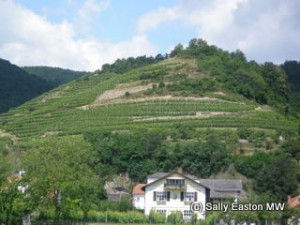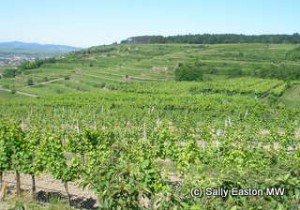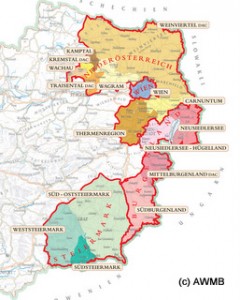Austria: vintage 2009 along the Danube
A tasting of wines from Austria’s river Danube wine regions reveals remarkable quality from the top producers despite a summer of cool and heat being sandwiched between a damp early and end of season.
Whilst quality was evidently high, volumes in the adjoining Danube regions of Wachau, Kremstal, Kamptal and Traisenthal were down about 30% in the two key varietals – grüner veltliner and riesling. Indeed Mathias Hirtzberger of Weingut Franz Hirtzberger said “we had only 40% of our normal riesling harvest for Singerriedel [vineyard site], and we’ve sold out”.
Roman Horvath MW, the managing director of Domäne Wachau said “2009 was a great vintage in Wachau and the neighbouring regions. We had strong rainfall at end of September which caused a ‘bad’ botrytis infection. But as the most western wine region, the grapes here were not as soft as elsewhere, so we did not have such a big loss. We had more time to work in the vineyard.”
Also in the Wachau, Leo Alzinger of Weingut Alzinger added “2009 was not easy because of the rainfall in mid-September. Both good and bad botrytis started, and we had to select out the good from the bad.” This took some effort. Where they normally harvest 60kg/hour, in 2009 Alzinger harvested at a rate of just 5kg/hour. But Alzinger said “it’s very good quality.” As you’d hope after all that effort.
Horvath added “it’s a very balanced year, and more concentrated than 2008. If people worked well in vineyard, there is a pure, precise fruit expression.” This theme was picked up by Maria Angeles Castellanos-Hiedler of Weingut Hiedler in the Kamptal who said the vintage showed great “purity and juiciness of fruit. There was no botrytis in 2009. There was lots of sunlight, giving pure fruits and fine minerality.”

Wachau vineyards
That rain at flowering was an issue, reducing the crop. Hiedler continued “the wind and rain began at the end of May, beginning of June. It was bad for quantity, but good for quality because [the poor flower fertilisation] resulted in loose bunches which then concentrated their fruit flavours.”
Fellow Kamptal vintner Johannes Hirsch of Weingut Hirsch picked up the rainy theme, but added “2009 finished with super healthy fruit in mid-October, which is normal. We never had so perfect riesling, and the grüner veltliners are fine and minerally. We didn’t expect this after the rainiest June in 200 years.”
On the opposite side of the Danube from Kamptal, Markus Huber of Weingut Huber in Traisental said “2009 was one of the best vintages in the last ten years. A cool growing season with low yields resulted in concentrated grapes. Physiological ripeness was quite late and there is enough acidity to balance the richness.”

Kamptal vineyards
A little further east along the Danube, heading towards Vienna lies Wagram, less completely focused on grüner veltliner and riesling, but still accounting for a worthy amount of production. Here there was less rainfall in September than further west, but the June rain was still “something like a flood” according to Franz Leth, of Weingut Leth, when “160mm of rain fell in three days. Hailstorms in the beginning of August, followed by three weeks of very hot weather made 2009 a vintage of weather extremes.”
But, Leth added “we were luckier than western areas of Danube, because we had little rainfall in September, so it was not such hard work selecting in the vineyard.” But volumes are still down around 30% in Wagram.
Despite the periodic rains, Willhelm Hamm, director of the wine estate, Weingut Stift Klosterneuburg, also in Wagram was optimistic, saying “from mid July to end Oct we had most beautiful weather you could imagine. We had a long vegetative period and therefore long hang time, and we didn’t have extremely high temperatures above 32 to 33°C. “
The June rains may have reduced the flowering and thus the yield across the regions of the river Danube, but such a yield reduction this early in the season means top producers don’t have to do so much green harvesting in later months. The looser bunches that resulted were nicely aerated, and fruit flavours subsequently concentrated. Growers spoke of vineyard work and very high quality wines.
Brief tasting highlights of the 2009 vintage. May 2010, at Vievinum in Vienna.
General, for both grüner veltliner and riesling at this level.
- All these are excellent wines, with unjustly brief notes.
- Just a couple from each producer
- Silkiness and persistence of texture throughout;
- Elegance and lightness of deportment allied with sometimes amazing depth and density.
Wachau
Weingut Alzinger, Grüner Veltliner Mühlpoint Smaragd, 2009, Wachau
Spicy with fresh/dry combo. Has weight and definition, long, strong, elegant stony palate. purity and spiciness.
Weingut Alzinger, Riesling Loibenberg Smaragd, 2009, Wachau
Apricot and citrus density, fresh, aromatic spices in a lush/fresh combo. Laser precision.
Weingut Franz Hirtzberger, Grüner Veltliner Rotes Tor Smaragd, 2009, Wachau
Cream/spice combo, great weight and flavour intensity. Long
Weingut Franz Hirtzberger, Riesling Hochrain Smaragd, 2009, Wachau
Crisp citrus fruit, apricot, precision with youthful energy and weight.
Weingut F. X Pichler, Grüner Veltliner Loibnerberg Smaragd 2009, Wachau
Fresh-cream, soft pepperiness, fresh and integrated
Weingut F. X Pichler, Riesling Loibnerberg Smaragd 2009, Wachau
Immediate lushness, purity and definition, density and length.
Weingut Veyder-Malberg, Grüner Veltliner Hochrain 2009, Wachau
Citrus cream-spice. Palate opulence, depth, purity and length.
Weingut Veyder-Malberg, Riesling Buschenberg 2009, Wachau
Peach and apricot, lush-dry combo, dense flavour with stunning depth and early complexity.
Domäne Wachau, Grüner Veltliner Kaiserberg Federspiel 2009, Wachau
(federspiel = lighter style). Citrus pith then white pepper, clean and defined. Light and refreshing, with attractive substance.
Domäne Wachau, Riesling Achleiten Smaragd, 2009, Wachau
Stone fruits and stoniness, tight/dry combo with fruit density, focus, deportment and long finish.
Kamptal
Weingut Willi Bründlmayer, Grüner Veltliner Käferberg 2009, Kamptal Reserve DAC, Erste Lage
(reserve style) Fresh, creamy, density, rich and dry with soft spice pepper.
Weingut Willi Bründlmayer, Riesling Heiligenstein 2009, Kamptal Reserve DAC, Erste Lage
(reserve style) Tropical and citrus, juicy and blossoming, dry/lush combo.
Weingut Hiedler, Grüner Veltliner Thal 2009, Kamptal Reserve DAC, Erste Lage
(reserve style) Soft, spicy lift, then fresh with a fat-dry combo; layered pepper and pith, dense and long.
Weingut Hiedler, Riesling Gaisberg 2009, Kamptal Reserve DAC, Erste Lage
(reserve style) Limey pith, citrus weight and purity. Focus and balance. juicy and immediately delicious.
Weingut Hirsch, Riesling Zöbing 2009, Kamptal DAC
(Lighter style) Lighter style. lime juiciness, energetic in its vibrant youth.
Weingut Hirsch, Riesling Zöbinger Heiligenstein 2009, Kamptal DAC, Erste Lage
(reserve style) Citrus pith, aromatic tropical spices, density and volume in the mouth.
Weingut Schloss Gobelsburg, Grüner Veltliner Gobelsburger 2009, Kamptal DAC
(lighter style). Fresh, light, lemon-cream; intense floral and pepper.
Weingut Schloss Gobelsburg, Riesling Heiligenstein 2009, Kamptal Reserve DAC, Erste Lage
(reserve style). Piquant aromatic spice, tropical fruit, dense and perky prickle on tongue; deft and complex.
Traisental
Weingut Markus Huber, Grüner Veltliner Obere Steigen 2009, Traisental DAC
(lighter style). light, peppery, citrus pith, attractive pepperiness with nice bit of fat.
Weingut Markus Huber, Riesling Berg 2009, Traisental Reserve DAC, Erste Lage
(reserve style) Rich, tropical/fresh combo, lime notes, round and long.




